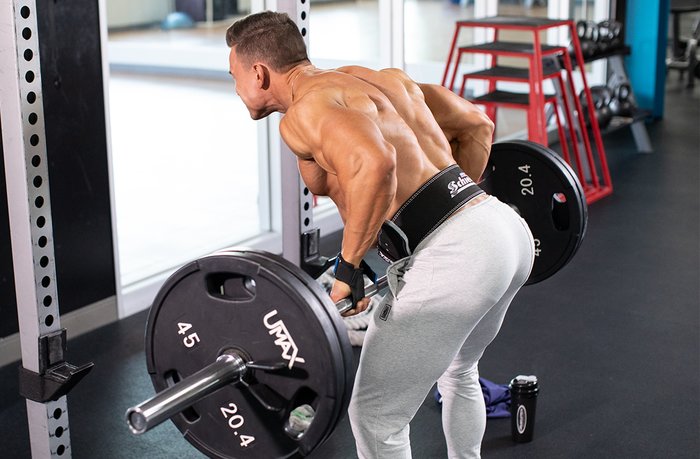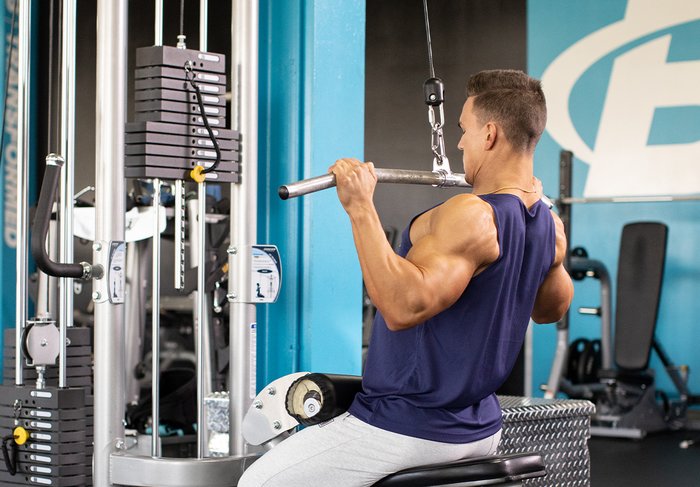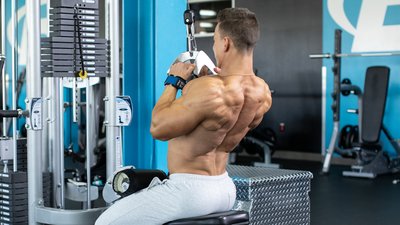Back is an out-of-sight, out-of-mind muscle group for many people. Unlike the chest, shoulders, arms, and abs, it doesn't easily catch your eye the way a biceps stretching out of a T-shirt sleeve or a ripped sixer does. Even more importantly, it can't be scrutinized for weaknesses when you're looking straight into a mirror.
The fix is simple—not easy, mind you, but simple. Just give your back the same attention as you give those other body parts and take the time to identify any developmental weaknesses.
These five tips will help you cover your back from every angle and build a complete upper body, from deep thickness around the spine to flaring, cobralike lats.
1. Row Big
Rowing is many things—uncomfortable, tough, sometimes brutal. Still, there's nothing quite like a basic barbell or dumbbell row to widen and thicken the back from every angle. The only problem: the way most lifters row, their lower backs give out before their lats get any love.
If that sounds familiar, drop the free weights and try the single-arm landmine row, aka, the Meadows row. This bad boy—a favorite of IFBB pro bodybuilder John Meadows—is performed using a barbell slid into a landmine apparatus on one end. If your gym doesn't have a landmine, wedge the empty end of a barbell into a corner, or use a T-bar row station. It allows you to go heavy while having just a bit more stability, putting the stress where it should be and not where it shouldn’t.
Stand in front of the loaded end of the bar, perpendicular to it. Bend at the hips so your back is angled slightly higher than parallel to the floor and grab the end of the bar with the inside hand using a palms-down grip as if you're about to do a dumbbell row. Pull the bar, bringing your elbow and shoulder blades back as your hand comes up toward your side. You can also brace your other forearm on the same-side thigh for balance.
2. Nix the Momentum
Using momentum during workouts isn't always a bad thing. For instance, if you're doing Olympic lifts, you're purposefully generating momentum to develop your explosive power. In other cases, though, slinging weight around takes the tension off the target muscle and can make an exercise much less effective.
If you want to maximize the development of your back, you need to take it slower on a majority of your movements, including rows, pull-downs, and pull-ups. For example, during deadlifts and rows, a short pause at the bottom of each rep can help dissipate momentum.
MuscleTech brand ambassador Abel Albonetti is a fan of one particular move that incorporates that very trait:

Pendlay Row
This barbell exercise includes a dead stop at the bottom of each rep, with the weight set down on the floor. To do it right, place your feet about shoulder-width apart, with the fronts of your ankles flush against the barbell. Bend at the hips and take an overhand grip on the bar, just outside your ankles. Your back should be parallel to the floor, with your core tight and your eyes looking ahead to a spot on the floor. Pull the bar to your upper abdomen, leading with your elbows as they bend and squeezing your shoulder blades together at the top. Lower the bar along the same path and reset, putting the weight on the floor for a second before you pull it straight up again.
3. Don't Just Pull Down—Pull Over
The classic dumbbell pull-over doesn't get its fair share of praise. Bodybuilding writers and gym lore haven't helped matters, muddying the waters as to whether it's a chest exercise or back exercise, and Arnold Schwarzenegger was known to say that it could help expand the ribcage. That dubious claim aside, the pull-over is a solid upper-body move that calls the lower pecs and the lats into play, with extra emphasis on the latter.
You can do it with a dumbbell, with your body crossways on the bench, or while lying normally on the bench, lowering the weight over the top edge of the bench behind your head. You can also switch things up by trying it with a barbell or EZ-curl bar or doing a standing variation in which you use a cable rope attachment, pulling the rope from overhead while facing away from the stack. Finally, if you're lucky enough to have the machine at your gym, you can do Nautilus pull-overs, preferred by no less an icon than six-time Mr. Olympia Dorian Yates, who said they really helped him widen his outer lats.

4. Strengthen Your Mind-Muscle Connection
Admittedly, it's a little harder to establish a strong mind-muscle connection with muscles you can't watch in the mirror. That means you'll need more practice to achieve connection perfection, and this lat pull-down variation offers a chance to do just that.
Kneeling Single-Arm Lat Pull-Down
Also called the kneeling single-arm high-pulley row, this exercise can make a huge difference in establishing the link between your brain and back for three important reasons:
- As a cable movement, the kneeling single-arm lat pull-down keeps the tension on the working muscle throughout, prompting greater activation of the lats as you work in the direction of the cable and giving you the chance to focus on the muscle contraction as you pull.
- Doing it unilaterally instead of using both arms simultaneously gives you a greater range of motion. Because each side has to handle a full load, you can focus on one lat at a time and also bring up a weaker side for balanced development.
- You are forced to cut back on the resistance. So often with back, because it's a powerful muscle, we overdo the poundage and correct performance goes out the window. The kneeling single-arm lat pull-down gives you a chance to prioritize form over ego gratification. (There's plenty of time for that with the compound exercises that should be front loaded in your program, like the single-arm landmine row, outlined above.)
To eliminate biceps assistance as much as possible, use a lifting strap around the handle. That reduces forearm and biceps involvement in your grip, so you pull almost exclusively with your back on every rep. In addition, when the handle is rising, roll your shoulder blades forward a bit to accentuate the lat stretch. As you start the next rep, contract your shoulder blades first, then pull.
Drop in the kneeling single-arm lat pull-down at or near the end of your back workout—4 sets of 12-15 reps should do the trick, resting 30-60 seconds between sets.
5. Finish Strong
Other than the glutes-quadriceps-hamstrings complex, your back is the strongest muscle group you've got. Add in the fact that the back is made up of multiple muscles, including the rhomboid major and minor, teres major and minor, latissimus dorsi, erector spinae, and trapezius, among other connecting groups, and you have a complicated body part to stimulate. In order to give every bit of it the attention it needs, make sure you're working multiple angles and using a number of grips throughout your back workout. A final movement that elicits utter exhaustion may help too, especially if you're struggling to get over a developmental plateau.

100-Rep Combo
This 100-rep finisher will help you break down any remaining stubborn muscle fibers and can be done with a pull-down movement or rowing exercise. Choose the former if you're looking to improve your width and the latter if you need thickness. You can also alternate the two from workout to workout if you want to improve both facets.
The key is to use a machine exercise rather than a free-weight move, since a fixed motion is the safer option for maximum effort, especially when you're already fatigued. Also, use straps to secure your grip—otherwise, your forearms will likely give out well before your back.
Pick a weight that would elicit failure at 20-25 reps, and have a clock with a second hand in sight, if possible. Here's how the finisher should break down from there:
- Do reps until you reach momentary muscle failure, where you can't do another with proper form. Take that number of reps and subtract it from 100 for your rest period—if you did 20 reps, rest 80 seconds.
- After 80 seconds, begin repping again until you reach failure, starting at 21. If you get to, say, 35, you rest 65 seconds this time, and then begin again.
- Keep going until you've done 100 reps in total. Toward the end, the number of reps you can get in one turn will decrease. Stick with the 100-minus-total-reps rest scheme, as it helps increase intensity by compressing your work-to-rest ratio.
- As you improve and get stronger with the weight you choose, you can bump up the resistance in a future workout.



